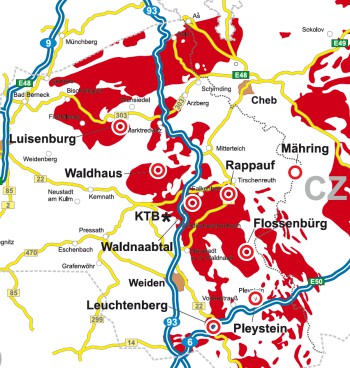
Standort 4: Mähring
Strahlender Granit – Radioaktivität im Stein
„Feldspat, Quarz und Glimmer – die vergess’ ich nimmer“ ist ein oft
zitierter Satz über die Zusammensetzung von Granit. Granit enthält noch
andere Minerale, von denen einige zur natürlichen radioaktiven Strahlung
in der Umwelt beitragen.

Zářící žula – radioaktivita v kameni
Živec, křemen a slída jsou hlavními minerálními složkami žuly. Žula (granit) obsahuje i další nerosty. Některé z nich jsou radioaktivní a zvyšují přirozenou radioaktivitu prostředí.

Radiating granite – radioactivity of the rock
Feldspar, quartz and mica are the most common minerals of granite, but numerous further minerals contribute in small quantities. Some of those are responsible for the natural radiation of granite.
Bildimpressionen

Tafelstandort in der Karte


Klicken Sie auf den Ortsnamen für mehr Informationen
Tafel 1: Leuchtenberg
Vom Magma zum FestgesteinOd magmatu k pevné hornině
From magma to solid granite
Tafel 2: Pleystein
Granit-Pegmatit – das Beste zum SchlussŽulový pegmatit
Granite pegmatite
Tafel 3: Flossenbürg
Naturwerkstein GranitDekorační kámen žula
Granite as a natural stone
Tafel 4: Mähring
Strahlender Granit – Radioaktivität im SteinZářící žula – radioaktivita v kameni
Radiating granite – radioactivity of the rock
Tafel 5: Grube Rappauf Tirschenreuth
Verwitterter Granit – Kaolin für die PorzellanindustrieKaolin pro porcelánový průmysl
Kaolin for the porcelain industry
Tafel 6: Waldnaabtal
Landschaftsformen im GranitŽulové krajinné útvary
Landscape shaped in granite
Tafel 7: Waldhaus Pfaben
Boden aus Granit – Bedeutung für den WaldPůdy na žule – význam pro les
Soil from granite – significance for the forest
Tafel 8: Wunsiedel Luisenburg
Verwitterungsformen im Granit – Felstürme, Wollsäcke und BlockmeereZvětrávací tvary žuly
Weathering of granite




